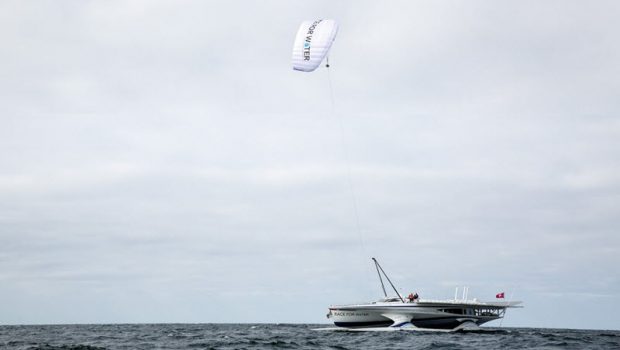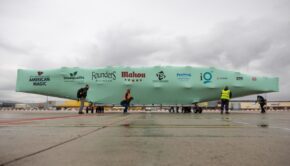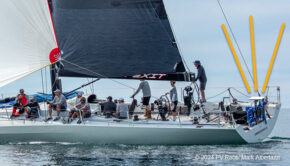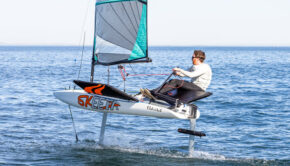Kiting Across the Atlantic Ocean
Published on May 12th, 2017
After a month at sea, sailing from Lorient to Bermuda, the crew of the revolutionary 35m Race for Water vessel has been learning the art, and the science, of their high-altitude kite. Currently in the middle of the Atlantic, the Race for Water is averaging 5 knots towards Bermuda, which will be the first stopover of this five year Odyssey focused on promoting ocean preservation.
This has been a period full of lessons for a crew getting to grips with and optimizing the clean and renewable technology on board. According to Martin Gavériaux (engineer) and Pascal Morizot (captain), the Race for Water consumes per hour on average 15 kW for its propulsion and 4 kW for the equipment on board. This represents an average daily energy consumption of 456 kWh for a speed of between 4 and 5 knots. Thanks to the 786-panel solar generator (489 m²), 600 kWh can be stored on a clear, sunny day.
Using the kite along the way has meant there have been considerable energy savings. The crew has tried their five different kites with surface areas ranging from 20m² to 40m². When the wind is between 10 and 25 knots, at an angle between 100 and 180 degrees in relation to the vessel’s trajectory, the kite makes it possible to completely relieve the electric motors most of the time. The solar panels then recharge the batteries, extending the operational range of the vessel.
Since the departure from Lorient on April 9, the kite has been used for 50 hours, spread over 11 days; for one hour on the shortest day and 14 hours on the longest, as well as 30 take-off and landing maneuvers. Controlled by an automatic pilot system, the kite traces a “figure 8” trajectory, familiar to kitesurfers, producing traction loads of 800 to 2000kg. That is a significant performance level for a vessel weighing 100 tons.
Martin explained that the launch of the kite remains the most delicate procedure of each flight. The crew uses the carbon masts positioned on either side of the cockpit as a launch ramp. However, operation is undemanding overall: the kite is brought on deck, hooked to the mast and traction line and then hoisted. The crew performs an initial check-up by computer, unfolds the kite which fills with air, and then the pilot and the winch are set up for the launch phase.
“We have to keep the kite stable and release the traction line in a precise and steady manner,” Gravériaux said. “When the wind is light it’s a particularly tricky operation. When the wind is strong, the kite flies better; it’s more stable, and so there’s less risk of stalling.”
Thanks to this mix of solar and kite energy production, as well as a course that has been plotted to avoid unfavorable winds, cross seas and heavily overcast areas, the crew has, so far, never had to restrict itself from an energy point of view. There is a particular focus on energy consumption, especially on the overall charge at the end of the day and in order to prevent overnight consumption. The kite has therefore already demonstrated its perfect complementarity with solar energy as a way of propelling and powering the Race for Water.
Race for Water in Bermuda from May 20 to July 7, 2017
An environmental partner of Groupama Team France, who are competing in the America’s Cup, the Race for Water is expected to arrive in Bermuda on around May 20 for its first stopover of the Odyssey. The vessel will be moored for a month and a half on the pontoon of Caroline Bay Marina. The crew will take advantage of this stopover to support the French Groupama crew led by Franck Cammas during the racing and above all to raise awareness about ocean preservation. They will welcome schoolchildren and representatives from Bermudian institutions on board their 100% energy self-sufficient vessel and unveil a solution for the production of energy from plastic waste.
The Race for Water Foundation program in Bermuda:
• Vessel arrival at Bermuda (ETA 23rd May): press conference on the Race for Water
• June 1: “Waste to energy” workshop hosted by Marco Simeoni and Camille Rollin (Race for Water Foundation)
• June 1: Charity Dinner: tour of the Race for Water and cocktails followed by a dinner at the Artemis base
• June 7, 8, 12 and 13: tours of the Race for Water by Bermuda schoolchildren and students organized by the Department of Energy of the government of Bermuda
• June 30: “Environment” workshop hosted by Anne Hyde (Keep Bermuda Beautiful) and Martin Gaveriaux (Race for Water Foundation)
• June 29 to July 7: Ephemare (Ecotoxicological effects of microplastics in marine ecosystems) scientific study (JPI Oceans) on the Race for Water, lead by professor Ricardo Beiras.










 We’ll keep your information safe.
We’ll keep your information safe.